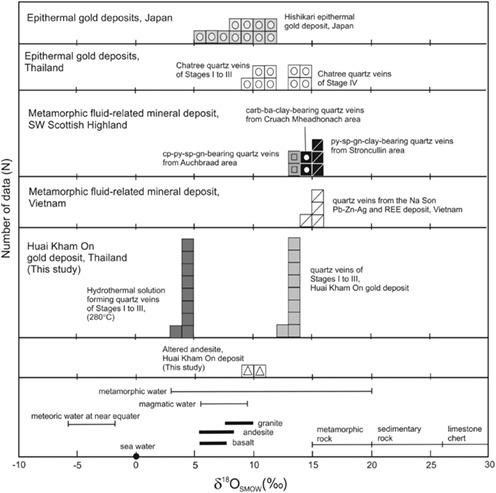当前位置:
X-MOL 学术
›
Resour. Geol.
›
论文详情
Our official English website, www.x-mol.net, welcomes your feedback! (Note: you will need to create a separate account there.)
Geochemical characteristics of gold mineralization of the Huai Kham On deposit, Sukhothai Fold Belt, Northern Thailand
Resource Geology ( IF 1.4 ) Pub Date : 2020-09-29 , DOI: 10.1111/rge.12246 Ladda Tangwattananukul 1 , Daizo Ishiyama 2 , Punya Charusiri 3
Resource Geology ( IF 1.4 ) Pub Date : 2020-09-29 , DOI: 10.1111/rge.12246 Ladda Tangwattananukul 1 , Daizo Ishiyama 2 , Punya Charusiri 3
Affiliation

|
The Huai Kham On gold deposit is located in the central part of the Sukhothai Fold Belt, northern Thailand. The Sukhothai Fold Belt represents an accretionary complex formed by subduction and collision between the Indochina and Sibumasu Terranes. There are many small gold deposits in the Sukhothai Fold Belt; however, the styles and formation environments of those gold deposits are not clear. The geology of the Huai Kham On deposit consists of volcanic and volcanosedimentary rocks, limestone, and low‐grade metamorphic rocks of Carboniferous to Triassic age. Gold‐bearing quartz veins are hosted by volcanic and volcanosedimentary rocks. The quartz veins can be divided into four stages. The mineral assemblage of the gold‐bearing quartz veins of Stages I and II comprises quartz, calcite, illite, pyrite, native gold, galena, chalcopyrite, and sphalerite. Quartz veins of Stage III consist of microcrystalline quartz, dolomite, calcite, pyrite, native gold, and chalcopyrite. Veins of Stage IV consist of calcite, dolomite, chlorite, and quartz. Fluid inclusions in quartz veins are classified into liquid‐rich two‐phase (Types IA and IB), carbonic‐aqueous (Type II), and carbonic (Type III) fluid inclusions. The homogenization temperatures of Types IA and II fluid inclusions that are related to the gold‐bearing quartz veins from Stages I to III ranged from 240° to 280°C. The δ18O values of quartz veins of Stages I to III range from +12.9 to +13.4‰, suggesting the presence of a homogeneous hydrothermal solution without temperature variation such as a decrease of temperature during the formation of gold‐bearing quartz veins from Stages I to III in the Huai Kham On gold deposit. Based on the calculated formation temperature of 280°C, the δ18O values of the hydrothermal solution that formed the gold‐bearing quartz veins range from +3.2 to +3.7‰, which falls into the range of metamorphic waters. The gold‐bearing quartz veins of the Huai Kham On deposit are interpreted to be the products of metamorphic water.
中文翻译:

泰国北部素可泰褶皱带怀卡姆矿床金矿化的地球化学特征
淮康安金矿位于泰国北部素可泰折叠带的中部。素可泰折叠带代表了印度支那和西布玛苏山脉之间俯冲和碰撞形成的增生复合体。素可泰折叠带中有许多小金矿。但是,这些金矿的样式和形成环境尚不清楚。淮康安矿床的地质组成包括火山岩和火山沉积岩,石灰岩和石炭纪至三叠纪的低品位变质岩。含金石英脉以火山岩和火山沉积岩为主体。石英脉可分为四个阶段。第一和第二阶段含金石英脉的矿物组合包括石英,方解石,伊利石,黄铁矿,原生金,方铅矿,黄铜矿和闪锌矿。第三阶段的石英脉由微晶石英,白云石,方解石,黄铁矿,原生金和黄铜矿组成。第四阶段的静脉由方解石,白云石,绿泥石和石英组成。石英脉中的流体包裹体分为富液两相(类型IA和I B),碳水(II型)和碳(III型)流体包裹体。与I至III期含金石英脉有关的I A和II型流体包裹体的均质温度范围为240°C至280°C。的δ 18个O值阶段I到III的范围石英脉从12.9到13.4 +‰,提示没有温度变化的均匀水热溶液的存在下,例如温度从阶段形成含金石英脉期间减少I至III在淮康安金矿。根据280℃时,δ计算出的形成温度18形成含金石英脉的热液的O值在+3.2至+ 3.7‰范围内,属于变质水域。淮康安矿床的含金石英脉被解释为变质水的产物。
更新日期:2020-09-29
中文翻译:

泰国北部素可泰褶皱带怀卡姆矿床金矿化的地球化学特征
淮康安金矿位于泰国北部素可泰折叠带的中部。素可泰折叠带代表了印度支那和西布玛苏山脉之间俯冲和碰撞形成的增生复合体。素可泰折叠带中有许多小金矿。但是,这些金矿的样式和形成环境尚不清楚。淮康安矿床的地质组成包括火山岩和火山沉积岩,石灰岩和石炭纪至三叠纪的低品位变质岩。含金石英脉以火山岩和火山沉积岩为主体。石英脉可分为四个阶段。第一和第二阶段含金石英脉的矿物组合包括石英,方解石,伊利石,黄铁矿,原生金,方铅矿,黄铜矿和闪锌矿。第三阶段的石英脉由微晶石英,白云石,方解石,黄铁矿,原生金和黄铜矿组成。第四阶段的静脉由方解石,白云石,绿泥石和石英组成。石英脉中的流体包裹体分为富液两相(类型IA和I B),碳水(II型)和碳(III型)流体包裹体。与I至III期含金石英脉有关的I A和II型流体包裹体的均质温度范围为240°C至280°C。的δ 18个O值阶段I到III的范围石英脉从12.9到13.4 +‰,提示没有温度变化的均匀水热溶液的存在下,例如温度从阶段形成含金石英脉期间减少I至III在淮康安金矿。根据280℃时,δ计算出的形成温度18形成含金石英脉的热液的O值在+3.2至+ 3.7‰范围内,属于变质水域。淮康安矿床的含金石英脉被解释为变质水的产物。



























 京公网安备 11010802027423号
京公网安备 11010802027423号